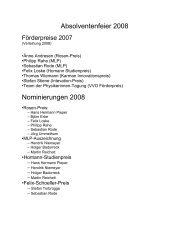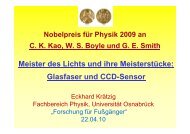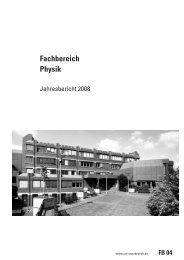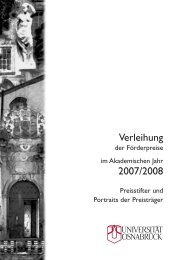Universität Osnabrück, Graduiertenkolleg Mikrostruktur oxidischer
Universität Osnabrück, Graduiertenkolleg Mikrostruktur oxidischer
Universität Osnabrück, Graduiertenkolleg Mikrostruktur oxidischer
Sie wollen auch ein ePaper? Erhöhen Sie die Reichweite Ihrer Titel.
YUMPU macht aus Druck-PDFs automatisch weboptimierte ePaper, die Google liebt.
GRADUIERTENKOLLEG MIKROSTRUKTUR OXIDISCHER KRISTALLE 69<br />
Surface Reactions: Monte Carlo Simulations of Systems with Creation,<br />
Annihilation and Diffusion of Energetically Interacting Reactants<br />
Beginn des Projekts: 01.06.1999<br />
Dipl.-Phys. Guntars Zvejnieks<br />
Betreuer: Prof. Dr. G. Borstel<br />
Abstract<br />
The standard Lotka-type model, which exhibits self-organized concentration oscillations, was introduced for the<br />
first time by Mai et al. (J. Phys. A: Math. 30, 4171, 1997) for a simplified description of autocatalytic surface<br />
reactions. To study (i) the resonance behavior and to determine (ii) the effect of mobile and energetically interacting<br />
reactants on oscillatory properties of the A+B→2B reaction, the corresponding mathematical model is<br />
modified here by incorporation of (i) periodic modulation of the only control parameter and (ii) diffusion of<br />
reactants (with/without energetic interaction between them), respectively. The mathematical formalism is proposed<br />
for determining the dependence of transition rates on the interaction energy (and temperature) for the<br />
general mathematical model, and the Lotka-type model in particular. By means of Monte-Carlo computer simulations,<br />
we have found that the modulation of the control parameter drives the system through a sequence of<br />
frequency locking, quasiperiodic, and resonance behavior. In turn, the diffusion leads to a desynchronization of<br />
oscillations and a subsequent decrease of oscillation amplitude. The energetic interaction between reactants has a<br />
dual effect depending on the type of mobile reactants. In the limiting case of mobile reactants B the repulsion<br />
results in a decrease of amplitudes. However, these amplitudes increase if reactants A are mobile and repulse<br />
each other. A simplified interpretation of the obtained results is given.<br />
Introduction<br />
In the last decade along with studies of dissipative structures in homogeneous catalytic reactions of the Belousov-Zhabotinskii-type,<br />
considerable attention was attracted to the heterogeneous catalytic reactions. They reveal<br />
a whole spectrum of synergetic effects, e.g., rate oscillations, concentration waves, spirals and chaos [1]. The<br />
heterogeneous systems are simpler than the homogeneous ones. Therefore, one can use for their study a number<br />
of powerful experimental and theoretical methods, which allow to determine the origin of spatio-temporal structures.<br />
In particular, the oscillatory kinetics was observed in heterogeneous catalysis on many metal surfaces as well as<br />
on oxide catalysts [1]. The mechanism of oscillations is different for various catalysts [2]. The more so, for the<br />
same catalyst the origin of oscillations is different in the high and low gas pressure limits. However, independently<br />
on the type of a catalyst, the global synchronization of oscillations is observed [1]. This fact implies the<br />
existence of very universal rules in the behavior of oscillatory systems, which exist independently on both type<br />
of catalyst and mechanism of a particular catalytic reaction.<br />
An important method for treating self-oscillating systems, in particular autocatalytic reactions, is the periodical<br />
variation of an external parameter in time and analysis of the system’s response. This has been done experimentally<br />
in Ref. [3] for the autocatalytic CO+1/2O2 reaction on Pt(110) surfaces in the low-pressure limit. In this<br />
study the external parameter, varied periodically in time, was the partial pressure of O2 gas above the Pt(110)<br />
sample. It was shown experimentally that, depending on the modulation frequencies, the self-oscillations in the<br />
system exhibit sub- and superharmonic resonance, phase locking, and quasiperiodic behavior.<br />
One of the theoretical methods used to attack the problem of catalysis is a Monte-Carlo (MC) computer simulation<br />
(see [4], [5] and references therein). Its role considerably increased during the last years due to increase of<br />
computational facilities. The idea of the MC method is to define a mathematical model, which accounts for basic<br />
experimentally detected reaction steps. The reactants are assumed to be classical particles (usually denoted as A,<br />
B, etc.), which can occupy sites on a discrete lattice. This allows easily to describe adsorption, desorption, diffusion<br />
and reaction of reactants as one- or two-site processes with the corresponding rates. Extension of the model<br />
to time dependent transition rates is straightforward. Both reconstructed and non-reconstructed surfaces can be<br />
modeled by assigning different sticking coefficients of reactants to lattice sites. Some models consist of more<br />
than ten-step reactions. A detailed mathematical model often complicates an analysis of simulation results and<br />
thus prevents from the understanding of basic driving mechanisms, e.g., the origin of synchronization of oscillations.







